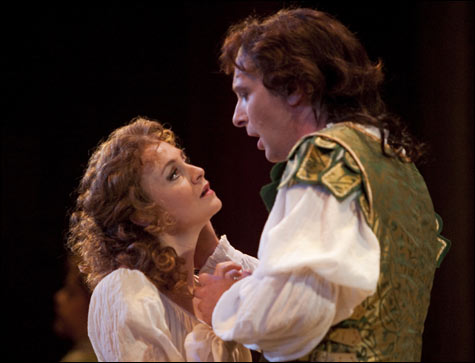
L’INCORONAZIONE DI POPPEA: Gillian Keith was an ideal Poppea, but Marcus Ullmann seemed miscast as Nerone. |
Two opera productions overlapping at the Calderwood Pavilion exploit exploitation. In one, contemporary lowlifes parade their darker hang-ups and seek redemption; in the other, the rich and power-hungry of ancient Rome seek only more riches and greater power and couldn't care less about redemption. In one, the characters include cross-dressers, transsexuals, and "poop fetishists"; in the other, women (or castrated men) sing some male roles and vice versa, and an assassin disguises himself as a woman. One juxtaposes high-flown parodies of opera, operetta, and oratorio with foul-mouthed contemporary slang; the other is the first great opera to deal with a historical subject. One tries hard to make a moral statement (quoting Blake's "Everything that lives is holy" as if it were Handel's Hallelujah Chorus); the other shows us amoral characters.
Richard Thomas & Stewart Lee's Jerry Springer: The Opera (2003), as up-to-date as pop culture and reality TV, was uninhibitedly staged by Paul Daigneault for SpeakEasy Stage Company, though with essentially one joke, it might be more effective at half its length. Monteverdi's L'incoronazione di Poppea (1642) gets more inspired as it goes along — and alongside our own news stories of greedy, lying, corrupt politicians, Poppea, which is about the accession of Emperor Nero's ambitious mistress to the throne, may have the greater contemporary relevance.
Monteverdi's opera is the centerpiece of this year's Boston Early Music Festival (replacing the originally announced Antiochus und Stratonica of Christoph Graupner, which will have to wait till 2013 and an economic upturn). Opening night it didn't come fully to life, despite some wonderful moments in its three and a half hours. The orchestra sounded inspired, with music directors (and score editors) Paul O'Dette and Stephen Stubbs imbedded in the ensemble playing chitarrone and Baroque guitar. And yet the whole lacked some underlying drive or pulse, something an actual conductor might have had an easier time supplying. Things, of course, could evolve, or vary, with each performance.
What won't change is Gilbert Blin's staging (he's also the set designer, and the 300-page program book for the festival devotes 14 columns to his detailed survey of Baroque theaters), which was mostly static and often not very responsive to the music. Monteverdi sets a tense scene between Poppea and the lover she's just thrown over "for a throne" as a kind of dance. It might have been exciting to see them do the steps and sidesteps of a psychological gavotte. But Blin's stock blocking conveyed no hint of dancing. A scene with three soldiers sent by Nerone to order Seneca's suicide was better because Blin seemed to be captivated by the musical madrigal. But in the ravishing final love duet (possibly written not by Monteverdi but by Benedetto Ferrari), Nerone and Poppea sing about gazing at each other and entwining, yet they're standing apart and doing neither.